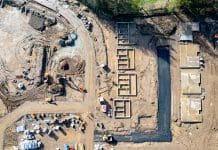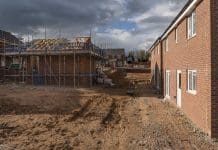RIBA’s Future Trends December 2023 shows optimism amongst larger practices, but expectations of falling architect workloads and staffing levels persevere
The Royal Institute of British Architects (RIBA) has published the findings from its latest Future Trends Survey, which show an overall expectation of falling workloads among architects.
The RIBA Future Trends Workload Index fell by 3 points to -9
A negative value indicates an expectation of falling work. Over the next three months, 20% of practices expect workloads to increase, 28% expect them to decrease, and 52% expect them to stay the same.
Smaller practices(1-10 staff) are less confident, falling by 3 points to -15, while medium (11+ staff) and large (50+ staff) practices reported a Workload Index figure of +30 – a 6-point increase from November.
All monitored work sectors maintain a negative outlook on future work, with three out of four more pessimistic than the previous month.
The Private Housing sector held steady at -16, the Commercial sector fell by 4 points to -5, the Public sector fell by 2 points to -9, and the Community sector fell by 7 points to -9.
Regionally, the picture remained generally dour. The North of England was the only region to improve by 9 points to +5, whereas Wales and the West fell back into negative territory after last month’s recovery, down by 19 points to -17; London (-5), the South of England (-14) and the Midlands & East Anglia (-23) all worsening.
Less than 10% of architect practices believe they will employ more staff
In December, the RIBA Future Trends Permanent Staffing Index rose by 1 point to -2, indicating a slight improvement, but practices still expect their permanent staff numbers to decrease over the next three months.
Small practices continue to expect staffing levels to decline, returning a Permanent Staffing Index figure of -5, the same as in November.
Medium and large practices once again expect an increase in permanent staff, returning a combined Permanent Staffing Index figure of +19, a considerable 14-point rise from November.
The Temporary Staffing Index slipped marginally to -6, suggesting falling numbers of temporary staff over the next three months and levels of personal underemployment increased from 22% in November to 26% in December.
Over the next three months, 9% of practices expect to employ more permanent staff, 11% expect to employ fewer, and 80% expect no change.
Adversarial economic conditions are still hampering growth
RIBA Head of Economic Research and Analysis Adrian Malleson said: “While the Consumer Price Index (CPI) and construction output price inflation are both on a downward trend, this has yet to translate into an uptick in architects’ commissions. These results indicate practices expect to reduce workloads and limit recruitment as they head into 2024.
“Practices also continue to report the challenges of still high inflation, high interest rates, elevated project costs, and ongoing planning delays, alongside diminished pipelines of work and low levels of enquiries. Some note planning delays being exacerbated by the level of detail required in planning submissions, deterring the progression of potential projects.
“We are also aware of heightened competition, including from ‘architectural designers’, which continues to intensify the downward pressure on fees, and an increasing number of reports of clients failing to pay invoices on time, threatening practice cash flow.”














